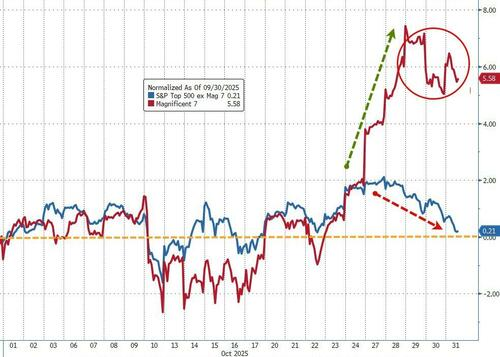Goldman Sachs traders pointed out that the U.S. stock market is showing extreme divergence: the Mag 7 continue to hit new highs, but the ratio of advancing to declining stocks on days when the S&P 500 rises has hit a record low. More notably, U.S. equities as a whole have underperformed global markets for 18 consecutive months. The heavy AI investments by tech giants are supporting their strong performance, but the weakening dollar and the recovery in European and Asian markets are driving the rise of non-U.S. markets, leading to more balanced breadth in the global market.
The U.S. stock market exhibits two major contradictions: tech giants repeatedly hitting new highs have driven index gains, but market breadth has narrowed to extreme levels, while the overall performance of U.S. stocks has lagged behind global markets for 18 consecutive months.
On October 31, Goldman Sachs trader Mark Wilson noted in an article that the Nasdaq Index recorded a 5% gain for two consecutive months, yet market concentration reached historical extremes. On Tuesday this week, when the S&P 500 Index rose, the ratio of advancing stocks to declining stocks hit its lowest level on record. This indicates that large U.S. tech stocks are dominating, while the other 493 constituents have remained virtually stagnant.

 Even more striking is that despite the strong performance of U.S. tech giants, U.S. stocks have underperformed global markets and failed to generate any excess returns over the past 18 months. This reflects two significant market phenomena in 2025: the weakening of the U.S. dollar and the recovery of non-U.S. markets such as Germany, Southern Europe, Japan, and South Korea, although these trends have not garnered as much attention as the topic of artificial intelligence.
Even more striking is that despite the strong performance of U.S. tech giants, U.S. stocks have underperformed global markets and failed to generate any excess returns over the past 18 months. This reflects two significant market phenomena in 2025: the weakening of the U.S. dollar and the recovery of non-U.S. markets such as Germany, Southern Europe, Japan, and South Korea, although these trends have not garnered as much attention as the topic of artificial intelligence.

Wilson believes that the ongoing narrowing of the U.S. market will pose performance challenges for many investors, but the current breadth of the global market is impressive and, supported by valuations and positioning, is likely to continue.
Tech Giants Outpace the Market as Concentration Reaches Extreme Levels
The article highlights that October market data clearly illustrates the extent of the concentration in U.S. stock gains.
The seven major U.S. tech stocks (Mag 7) significantly outperformed the remaining 493 constituents of the S&P 500 Index, which were essentially flat for the month. The seven giants broke out to new significant highs relative to the S&P 500 Index, continuing their role as the central narrative of the market.

This narrowing trend has become increasingly extreme. On Tuesday, when the S&P 500 Index rose, the ratio of advancing to declining stocks hit a record low. Despite Nasdaq’s continuous 5% rise over two months, market breadth continued to deteriorate.

Goldman Sachs trader Mark Wilson believes that the sustained AI investments by major technology companies are the core factor supporting their stock performance. According to a previous article by Wall Street News, Amazon and Google’s cloud businesses have accelerated growth, while Microsoft maintained a 39% growth rate, making it unlikely for these companies to slow down their spending plans in the short term.
He also pointed out that Meta is facing investor scrutiny over demonstrable return on investment this quarter, but given the competitive landscape, the company is unlikely to cut expenditures. Its $125 billion bond issuance received record demand, confirming its ability to sustain investments. Although stock price reactions may act as a constraining mechanism, if Meta’s share price does not drop significantly within a week, this debate will maintain the current status quo.
Following the Q3 earnings report, the Mag 7’s 2026 capital expenditure plan may increase by another $60 billion. Against this backdrop, NVIDIA becoming the first company to achieve a market capitalization exceeding $5 trillion is well-deserved.
European markets are quietly consolidating, with global performance breadth supporting subsequent trends.
Mark Wilson noted that although Asian markets dominated headlines this week, substantive changes are occurring in European markets. Airbus, Thales, and Leonardo announced the merger of their satellite businesses to create a pan-European industry leader—a small but significant step.
Consolidation in Europe’s telecommunications industry continues to advance, with new deal announcements in both the UK and Italy this week. These may not be ‘AI winners,’ but they are precisely the traditional industries where AI-driven efficiency improvements should be evident.
Italian utility company ENEL has just begun responding to the theme of ‘AI-powered grid upgrades.’ Its valuation, combined with earnings-per-share momentum, has driven the stock to a 12-month relative high. European large-cap stocks are starting to shake off the year’s currency drag, with Airbus, ASML, and ENEL all hitting 12-month relative highs.

The Goldman Sachs Asia team believes that the trend in the US dollar still supports earnings-per-share expectations in Asia and broader equity market performance, with China’s GDP forecast revised upward once again.
Wilson noted that the breadth of the current global market performance is impressive and is likely to continue, supported by positioning and valuation.
